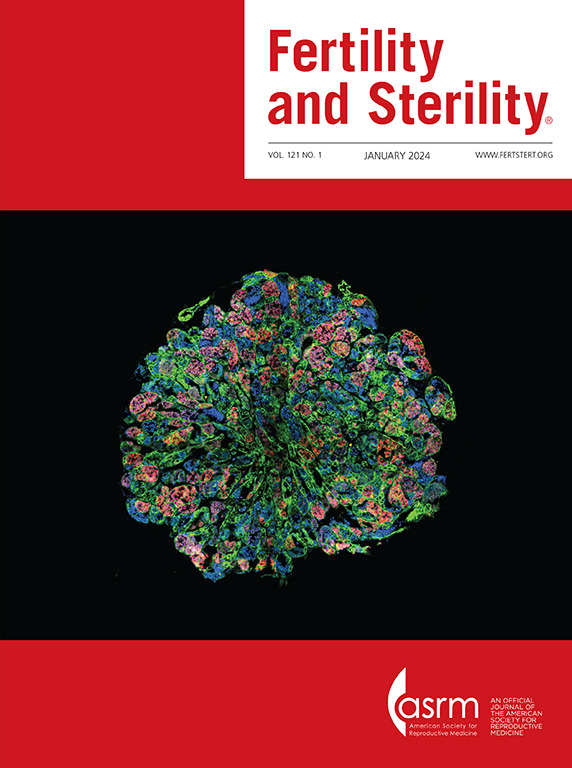Patients with a body mass index ≥45 kg/m2 can safely undergo oocyte retrievals and anticipate similar assisted reproductive technology outcomes.
IF 6.6
1区 医学
Q1 OBSTETRICS & GYNECOLOGY
引用次数: 0
Abstract
OBJECTIVE To compare anesthesia and assisted reproductive technology (ART) outcomes in patients with a body mass index (BMI) of 40-44.9kg/m2 to those with a BMI ≥45kg/m2 as these patients are often excluded from care. DESIGN Retrospective cohort study SUBJECTS: All patients with a BMI ≥40kg/m2 undergoing oocyte retrieval for ART from January 2018-2023 from one academic fertility clinic and one private fertility clinic. EXPOSURE BMI ≥45kg/m2 compared to a BMI of 40-44.9kg/m2. MAIN OUTCOME MEASURES The primary outcome was anesthesia complications at the time of retrieval. Demographic data, cycle specific information, medical comorbidities, BMI at retrieval, length of oocyte retrieval, ART and anesthesia complications, laboratory data, and pregnancy rates were recorded. RESULTS A total of 98 patients with a BMI ≥40kg/m2 undergoing oocyte retrieval were identified for the study, 56 patients with a BMI from 40-44.9kg/m2 and 42 patients with a BMI ≥45kg/m2. Demographics were not statistically different between both groups, except more patients with a BMI 40-44.9 kg/m2 identified as White (73% vs 60%) or Black (9% vs 0%), p=0.03. All patients were successfully managed with intravenous sedation and did not require higher level of sedation or care. Mean surgical duration was longer for patients with a BMI ≥45 kg/m2 than in those with a with a BMI 40-44.9 kg/m2 (26.8min, SD 13min vs. 22.3min, SD 8.4min, p=0.04). Most patients (93%) did not experience any anesthesia complication. The only adverse anesthesia complication in both groups was oxygen desaturation <90%, which did not differ by cohort even when adjusting for age. There was no difference in the number of mature oocytes retrieved, day 5/6 blastocysts, the number of euploid embryos, clinical pregnancy, miscarriage or live birth rates. CONCLUSION BMI is commonly used as a threshold for access to ART. When using intravenous sedation, patients with BMI ≥45 kg/m2 have similar ART outcomes with few anesthesia or ART complications in comparison to patients with a BMI of 40-44.9 kg/m2. With appropriate counseling and preoperative preparation, patients with a BMI ≥45 kg/m2 can safely undergo oocyte retrieval.体重指数≥45 kg/m2的患者可以安全地进行卵母细胞提取,并预期类似的辅助生殖技术结果。
目的比较体重指数(BMI)为40-44.9kg/m2的患者与体重指数≥45kg/m2的患者的麻醉和辅助生殖技术(ART)结果,因为这些患者通常被排除在治疗之外:2018年1月-2023年期间,来自一家学术生殖诊所和一家私人生殖诊所的所有BMI≥40kg/m2的患者接受ART卵母细胞取卵术.EXPOSUREBMI≥45kg/m2与BMI为40-44.9kg/m2相比.MAIN OUTCOME MEASUREST主要结果是取卵时的麻醉并发症。记录人口统计学数据、周期特定信息、合并症、取卵时的体重指数、取卵时间、ART 和麻醉并发症、实验室数据以及妊娠率。结果共有 98 名体重指数≥40kg/m2 的患者接受了卵母细胞取出术,其中 56 名患者的体重指数为 40-44.9kg/m2,42 名患者的体重指数≥45kg/m2。两组患者的人口统计学差异不大,但 BMI 为 40-44.9 kg/m2 的患者中白人(73% 对 60%)或黑人(9% 对 0%)更多,P=0.03。所有患者均成功接受了静脉镇静,无需更高级别的镇静或护理。体重指数≥45 kg/m2患者的平均手术时间长于体重指数为40-44.9 kg/m2的患者(26.8分钟,SD 13分钟 vs 22.3分钟,SD 8.4分钟,P=0.04)。大多数患者(93%)未出现任何麻醉并发症。两组患者中唯一的不良麻醉并发症是血氧饱和度<90%,即使考虑年龄因素,不同组别之间也没有差异。取回的成熟卵母细胞数、第 5/6 天囊胚数、优生胚胎数、临床妊娠率、流产率或活产率均无差异。与体重指数为 40-44.9 kg/m2 的患者相比,在使用静脉镇静剂时,体重指数≥45 kg/m2 的患者与体重指数为 40-44.9 kg/m2 的患者在麻醉或 ART 并发症方面的结果相似。通过适当的咨询和术前准备,体重指数≥45 kg/m2 的患者可以安全地进行卵母细胞提取。
本文章由计算机程序翻译,如有差异,请以英文原文为准。
求助全文
约1分钟内获得全文
求助全文
来源期刊

Fertility and sterility
医学-妇产科学
CiteScore
11.30
自引率
6.00%
发文量
1446
审稿时长
31 days
期刊介绍:
Fertility and Sterility® is an international journal for obstetricians, gynecologists, reproductive endocrinologists, urologists, basic scientists and others who treat and investigate problems of infertility and human reproductive disorders. The journal publishes juried original scientific articles in clinical and laboratory research relevant to reproductive endocrinology, urology, andrology, physiology, immunology, genetics, contraception, and menopause. Fertility and Sterility® encourages and supports meaningful basic and clinical research, and facilitates and promotes excellence in professional education, in the field of reproductive medicine.
 求助内容:
求助内容: 应助结果提醒方式:
应助结果提醒方式:


